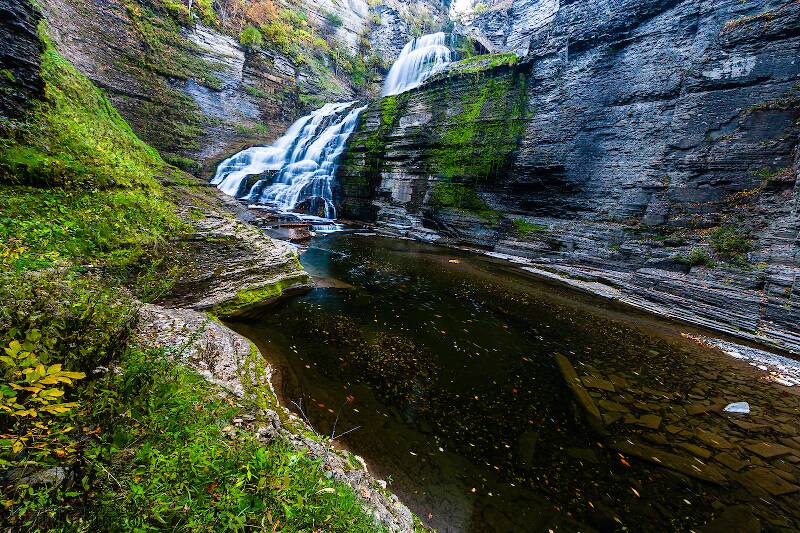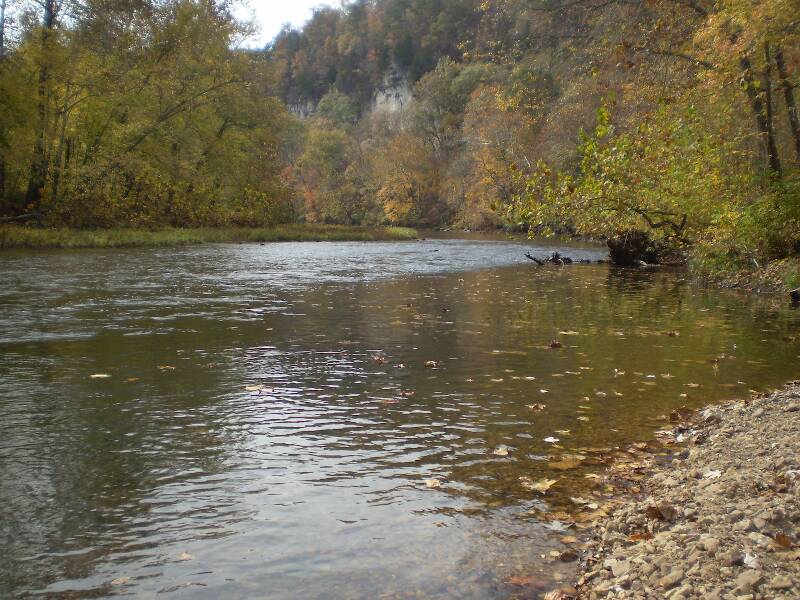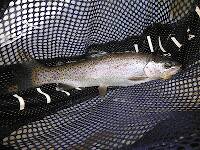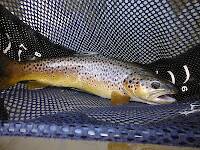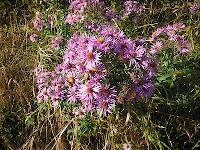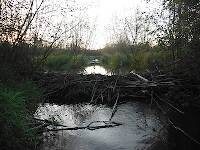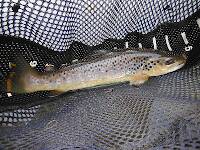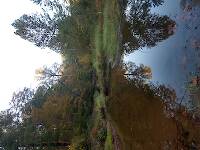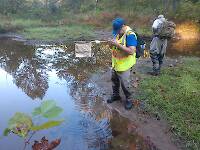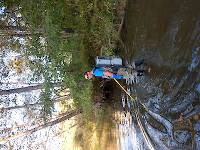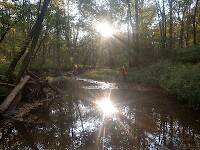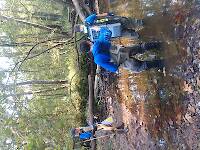
Salmonflies
Pteronarcys californica
The giant Salmonflies of the Western mountains are legendary for their proclivity to elicit consistent dry-fly action and ferocious strikes.
Featured on the forum

This seems to be a young larva of Limnephilus. Although not clear in the picture, several ventral abdominal segments have chloride epithelia.

Troutnut is a project started in 2003 by salmonid ecologist Jason "Troutnut" Neuswanger to help anglers and
fly tyers unabashedly embrace the entomological side of the sport. Learn more about Troutnut or
support the project for an enhanced experience here.
Ericd on May 11, 2010May 11th, 2010, 3:03 pm EDT
I decided to take a day and hike around the "metro area" DNR-classified trout streams within 20-40 minutes of my house for the first time. Some of the streams seemed perfect for trout if it were not for the beaver work. There must be a trout or two in some of the dams, but I didn't see any signs. Several trout streams are within 40 minutes of your front door that could be good fishing if it was not for the beavers.
What do you think?
What do you think?
Martinlf on May 11, 2010May 11th, 2010, 4:03 pm EDT
I have very limited experience with trout and beavers, but in a high mountain Colorado stream I once found many brookies living in beaverdam pools. I suppose the question is how warm do the pools get and would the stream stay cold enough without the beaver dams.
"He spread them a yard and a half. 'And every one that got away is this big.'"
--Fred Chappell
--Fred Chappell
Jmd123 on May 11, 2010May 11th, 2010, 6:50 pm EDT
Eric, the beaver ponds I have hit in Michigan are generally FULL of trout, browns as well as brookies. I have heard all of the arguments as to why beaver dams are supposed to be bad for trout streams, but my personal experiences have been quite the opposite - these places tend to fill with more and larger trout than the rest of the stream. This is true on Carp Creek on the north shore of Burt Lake; Klacking Creek draining to the Rifle River; and numerous coastal streams in Oregon (sea-run cuttroats there). And a fellow I once worked with in northern MI said that the best way to taske out a beaver dam was with dynamite - and that you had better have a net handy for all of the dead brookies that would floating up...
If I were you I would go hit those ponds. You might not see the fish but I bet they're there. You might just find yourself a real bonanza!
Jonathon
If I were you I would go hit those ponds. You might not see the fish but I bet they're there. You might just find yourself a real bonanza!
Jonathon
No matter how big the one you just caught is, there's always a bigger one out there somewhere...
Troutnut on May 11, 2010May 11th, 2010, 8:32 pm EDT
I'm not familiar with the scientific literature on this topic, but my pet hypothesis is that beaver dams are good for trout in systems that flood frequently and blow them out every once in a while, and bad for trout in stable systems where they block movement and cover miles of the channel in silt for years at a time.
Jason Neuswanger, Ph.D.
Troutnut and salmonid ecologist
Troutnut and salmonid ecologist
Ericd on May 12, 2010May 12th, 2010, 11:51 am EDT
I had my gear with me, but the lack of trout signs was so obvious that I didn't even attempt to find any. Maybe, I have to go further downstream. Thanks for the advice.
Jmd123 on May 12, 2010May 12th, 2010, 7:54 pm EDT
Eric, what exactly do you mean by "lack of trout signs"?? I have been in numerous beaver pond situations and seen absolutely "no sign" of trout (which I rarely EVER see ANYWHERE unless there is a big hatch and active surface feeding going on!) until I dropped a fly on the edge of an undercut bank or next to a submerged log and then WHAM!! Those fish aren't going to be out in the open where you can see them, because if you can, so can the herons and kingfishers and bald eagles and egrets and ospreys and...
Once many years ago in Missouri, I was fishing a lovely little stream called Capps Creek (highly recommended!) and I bumped into an older fella. He was used to fishing at MO's "trout parks", four large hatcheries built around enormous Ozark springs (we're talking hundreds of millions of gallons per day of ice-cold ground water). Well, at these parks, they release fresh trout every single day, in fact blowing a whistle at 8 a.m. so the old codgers can wake up, throw their Powerbait (or whatever, so long as it looks, smells, and tastes like hatchery trout pellets), catch their 5-trout limit, and go back to sleep. The water is crystal-clear and you can see these fish all over the place, including nice big ones who have seen everything known to man and won't hit ANYTHING. NOT my kind of fishing!!!!!! Nevertheless, this fellow thought that kind of fishing was NORMAL, and he remarked that he was amazed that he saw NOT ONE TROUT in Capps Creek no matter how far he walked! "Oh, I suppose maybe they're hiding from the birds or something." Gee, DO YA THINK?????????? (BTW, I pulled a nice brownie and two rainbows from this "fishless" stream over the course of the next few hours, and the brownie ended up as shore lunch.)
I do have to mention one time when my ex-wife and I were fishing a beaver pond up on Carp Creek. She kept mentioning a "school of trout" that I had to come see, and when I finally did, I was amazed to see perhaps a hundred trout, browns and brookies 6-10" long, literally stacked on top of one another in one pool of this beautiful beaver pond we were exploring. However, this was by far the exception to the rule. In almost every other case, I didn't know anyone was in there until it was dancing on the end of my line...
Try dropping a size 10 black or olive Woolly Bugger into one of these beaver ponds and then report back to me later.
Jonathon
Once many years ago in Missouri, I was fishing a lovely little stream called Capps Creek (highly recommended!) and I bumped into an older fella. He was used to fishing at MO's "trout parks", four large hatcheries built around enormous Ozark springs (we're talking hundreds of millions of gallons per day of ice-cold ground water). Well, at these parks, they release fresh trout every single day, in fact blowing a whistle at 8 a.m. so the old codgers can wake up, throw their Powerbait (or whatever, so long as it looks, smells, and tastes like hatchery trout pellets), catch their 5-trout limit, and go back to sleep. The water is crystal-clear and you can see these fish all over the place, including nice big ones who have seen everything known to man and won't hit ANYTHING. NOT my kind of fishing!!!!!! Nevertheless, this fellow thought that kind of fishing was NORMAL, and he remarked that he was amazed that he saw NOT ONE TROUT in Capps Creek no matter how far he walked! "Oh, I suppose maybe they're hiding from the birds or something." Gee, DO YA THINK?????????? (BTW, I pulled a nice brownie and two rainbows from this "fishless" stream over the course of the next few hours, and the brownie ended up as shore lunch.)
I do have to mention one time when my ex-wife and I were fishing a beaver pond up on Carp Creek. She kept mentioning a "school of trout" that I had to come see, and when I finally did, I was amazed to see perhaps a hundred trout, browns and brookies 6-10" long, literally stacked on top of one another in one pool of this beautiful beaver pond we were exploring. However, this was by far the exception to the rule. In almost every other case, I didn't know anyone was in there until it was dancing on the end of my line...
Try dropping a size 10 black or olive Woolly Bugger into one of these beaver ponds and then report back to me later.
Jonathon
No matter how big the one you just caught is, there's always a bigger one out there somewhere...
Ericd on May 13, 2010May 13th, 2010, 10:09 am EDT
The dams I'm speaking of are about 15 feet wide and maybe a foot and half deep with crystal clear water. There may be some larger ponds further than I hiked, but it was getting pretty difficult in the hip boots I decided to wear. Next time I'll bring the chest waders.
Someone pointed out to me that "designated trout streams" by our DNR only means that the water is suitable for trout and does not suggest that there are trout. Seems silly to me to include those streams on the DNR trout fishing guides.
Eric
Someone pointed out to me that "designated trout streams" by our DNR only means that the water is suitable for trout and does not suggest that there are trout. Seems silly to me to include those streams on the DNR trout fishing guides.
Eric
Jmd123 on May 13, 2010May 13th, 2010, 10:57 am EDT
Eric, there are loads of so-called "designated trout streams" on the Michigan DNR maps that don't have jack sh*t for trout in them. I was told by someone - don't remember if he was with DNR or not - that if there EVER was a trout found in a stream, even one little guy, it could be called a "designated trout stream". In many cases, trout used to be found in them but haven't been seen in many years, as was the story about a little creek that drained the lake I lived on in northern lower MI. I just recently found out from a local watershed council member that a place I went fishing for steelhead this past winter - marked on the maps as a trout stream, only species that could be kept in winter was rainbow/steelhead - turns out to be a BASS stream with few to no trout in it whatsoever. That must be why I caught no steelhead but instead a 17" largemouth there last November!! Not only that, but there are streams out there WITH TROUT that are NOT marked on the maps, e.g., the main branch of the Au Gres River - one day I pulled out an 8" yellow perch, a 10" rainbow, a 12" largemouth, and a 14" smallmouth, and I also saw lots of juvenile steelhead in that reach as well. There's even supposed to be BROOK TROUT in a stream that is not on the maps about an hour north of me, and I might be checking that out this coming weekend with my cousin who lives in the area.
As far as the beaver ponds are concerned, look for logs and other shelter that might conceal fish, including up near the dam itself, and try dropping your flies there. Try those Woolly Buggers or maybe an attractor dry (think Royal Coachman or Royal Wulff - brookies love 'em both), or later in the season a grasshopper (if in a meadow) or cricket or katydid imitation (if more wooded). This is actually closer to you than me: on my Isle Royale kayaking trip back in 2000, I pulled a nice 10" brookie from a beaver pond on the island by dropping a grasshopper imitation within about a foot of the dam. BANG!!
Good luck and tell me how you do!
Jonathon
P.S. Try to be STEALTHY in your approach to these ponds if the water is that clear, like hands and knees if necessary, wear only muted earth tone colors, move slowly and carefully, and use the lightest rod you have - I have a 7-foot 3-weight that is perfect for such places.
As far as the beaver ponds are concerned, look for logs and other shelter that might conceal fish, including up near the dam itself, and try dropping your flies there. Try those Woolly Buggers or maybe an attractor dry (think Royal Coachman or Royal Wulff - brookies love 'em both), or later in the season a grasshopper (if in a meadow) or cricket or katydid imitation (if more wooded). This is actually closer to you than me: on my Isle Royale kayaking trip back in 2000, I pulled a nice 10" brookie from a beaver pond on the island by dropping a grasshopper imitation within about a foot of the dam. BANG!!
Good luck and tell me how you do!
Jonathon
P.S. Try to be STEALTHY in your approach to these ponds if the water is that clear, like hands and knees if necessary, wear only muted earth tone colors, move slowly and carefully, and use the lightest rod you have - I have a 7-foot 3-weight that is perfect for such places.
No matter how big the one you just caught is, there's always a bigger one out there somewhere...
Motrout on May 13, 2010May 13th, 2010, 12:28 pm EDT
Beaver ponds are great, at least for the first couple years after they are created. On my home stream, there is a nice big one about a half mile up from the access-it's always the first place I try. On just about all the fast, shallow little brook trout creeks in Colorado have them too, and they nearly always hold a few 12-14 inchers, and in streams that in other areas hold few trout over 5". I think beaver ponds usually have 3-5 good years of fishing before they get stagnant and silted up-that's starting to happen on the little beaver pond on my home creek, and pretty soon I'll have to find another run to spend most of my time on.
"I don't know what fly fishing teaches us, but I think it's something we need to know."-John Gierach
http://fishingintheozarks.blogspot.com/
http://fishingintheozarks.blogspot.com/
Jmd123 on May 13, 2010May 13th, 2010, 2:02 pm EDT
Motrout, 3-5 years is about as long as many, if not most, beaver dams in Michigan survive before a good strong storm blows them out. What is amazing is the lush vegetation that grows back in over the sediments from the former pond. I wonder if this changing dynamic of dam building, blowout, and revegetation contributes to the productivity of the stream. In other words, maybe the beavers contribute to trout production more than just providing more space.
Let's remember, people, beavers and trout evolved together for thousands, if not millions, of years. I think it's strictly a human-centric viewpoint to think that beavers are somehow "bad" for the environment. It's entirely possible that the construction and blowout of beaver structures increases habitat complexity on the stream and therefore creates more shelter, backwaters, feeding areas, increased insect production, etc. I have certainly seen this on coastal Oregon streams that were channelized around 100 years ago - the beaver structures are forcing the channels to move around and braid and create new habitat and refugia for sea-run cuttroat trout and coho salmon.
I strongly doubt that a beaver pond could cause serious warming on a low-order stream that flows through forested areas, like those in northern lower MI or coastal OR. In my humble opinion, if beaver dams are causing trouble, it's because human activities have already impacted the stream and are causing warming, siltation, etc. above and beyond what a few beavers could ever do on their own.
Quit picking on the cute little buggers!!
Jonathon
Let's remember, people, beavers and trout evolved together for thousands, if not millions, of years. I think it's strictly a human-centric viewpoint to think that beavers are somehow "bad" for the environment. It's entirely possible that the construction and blowout of beaver structures increases habitat complexity on the stream and therefore creates more shelter, backwaters, feeding areas, increased insect production, etc. I have certainly seen this on coastal Oregon streams that were channelized around 100 years ago - the beaver structures are forcing the channels to move around and braid and create new habitat and refugia for sea-run cuttroat trout and coho salmon.
I strongly doubt that a beaver pond could cause serious warming on a low-order stream that flows through forested areas, like those in northern lower MI or coastal OR. In my humble opinion, if beaver dams are causing trouble, it's because human activities have already impacted the stream and are causing warming, siltation, etc. above and beyond what a few beavers could ever do on their own.
Quit picking on the cute little buggers!!
Jonathon
No matter how big the one you just caught is, there's always a bigger one out there somewhere...
Motrout on May 13, 2010May 13th, 2010, 2:09 pm EDT
Hey, I think beavers should be left to do their thing. Never said otherwise.
They were here first after all.
They were here first after all.
"I don't know what fly fishing teaches us, but I think it's something we need to know."-John Gierach
http://fishingintheozarks.blogspot.com/
http://fishingintheozarks.blogspot.com/
TNEAL on May 13, 2010May 13th, 2010, 2:12 pm EDT
Jmd123:
It's good to remember that, in Northern Michigan, we don't have trout streams... we have Grayling streams that have been attempted to be converted to trout streams. Will this experiment work?
It's good to remember that, in Northern Michigan, we don't have trout streams... we have Grayling streams that have been attempted to be converted to trout streams. Will this experiment work?
Jmd123 on May 13, 2010May 13th, 2010, 2:36 pm EDT
Point well taken, but the brookies and browns seem to be doing well and reproducing quite successfully. Although I don't necessarily agree with it from a purely ecological standpoint, it appears to be that the experiment has been successful. Sadly, however, we don't know much of anything about the ecological requirements of the Michigan grayling, as it was wiped out before hardly anyone really took notice. And, trout were being planted as they were in decline...Though, brookies ARE the native fish in Carp Creek, my favorite location to fish beaver dams. There's plenty of brownies in there too, and I've seen 15"+ fish in those pools that I doubt would be there if the channel was only 6 feet wide and six inches deep...
Jonathon
Jonathon
No matter how big the one you just caught is, there's always a bigger one out there somewhere...
TNEAL on May 14, 2010May 14th, 2010, 1:27 am EDT
Jonathon,
40 years ago, we had trout populations on parts of the AuSable that approached 10,000 per mile... it's now a much smaller fraction of that...
Tim
40 years ago, we had trout populations on parts of the AuSable that approached 10,000 per mile... it's now a much smaller fraction of that...
Tim
Oldredbarn on May 14, 2010May 14th, 2010, 5:18 am EDT
I will apologise here up front for moving this thread in a slightly different direction. I know it started out about beavers, but...
I am very happy that Tim Neal is posting here. I have mentioned before that he is one of the keepers of the flame for old Au Sable fishing flies. I have known his flies for 20+ years. Most of us guys on this site would be setting up our stuff for a fly tying session and Tim would have already produced 20 dozen packed up and ready to be shipped to the fly shop...Everyone of them would look exactly the same...Most of us Au Sable River Rats believe he and Jerry Regan tie in their sleep but we have been unable to prove this.
Re: the changes in the Au Sable...Tim. Do you remember when it was that the MI DNR stopped planting trout in the upper parts of the river we know, Mainstream, South Branch, & North Branch? Jamming the river with hatchery trout and sustaining a healthy wild trout population may be two different things.
The "improvements" along the river post Natural River designation, if you agree with me that this has had an effect or not, may have removed by-products leeching from old septic fields and washing machines along the river from downtown Grayling to say Wakeley Bridge...Some of this "stuff", we know, caused instream growth of weeds which seems to have decreased over time.
Just prior to our evening Sulpher action there is a hatch of the fly Tim & I know as the Pseudocloen anoka (the Angler's Curse)and he's a tiny little shit #24's or smaller...This is usually over looked, but there is fun to be had and just downstream from every weed patch in the river there were Brookies waiting for the little guys to let go of the weeds and float down to them for an early dinner.
There does seem to be fewer weeds or plant growth in the river. I can't remember the fish biologist guy (Alexander or something like that) wrote a piece for the "River Watch" years back where he concluded that we needed some decomposing bio-mass in the river to feed the bugs and then the trout. I think he was hinting that the river could be too clean in a weird way.
Back then they were proposing dumping leaves in to the river from lawns etc to try and add some food source for the bugs...I don't think anything ever came of this experiment.
The statement you sent me in a PM about the biologist guy thinking we may be at the beginning of the end of the great experiment of turning the Au Sable from a Grayling stream to a trout stream filled with non-natives is interesting. What is the proper number of fish in an environment where we have introduced them, where they haven't been before? Is it just about the numbers? I don't know...
We have "wild" trout in the Au Sable now and the numbers there now may be the proper self sustaining population numbers??? In Michigan we have messed with the river systems with the stocking of non-native salmon and steelies for quite some time now. I think there are a lot of questions unanswered about the good and bad sides of us humans manipulating nature for our entertainment...Sometimes I think I've come close to answering some of these questions, but that's usually at the Riverside Tavern in Lovell's or Spike's Keg-O-Nails in Grayling and usually after several Molson Canadians and a basket of onion rings...The problem is Tim, I always forget to write the damn stuff down!
Take Care! Keep the faith...
Spence
I am very happy that Tim Neal is posting here. I have mentioned before that he is one of the keepers of the flame for old Au Sable fishing flies. I have known his flies for 20+ years. Most of us guys on this site would be setting up our stuff for a fly tying session and Tim would have already produced 20 dozen packed up and ready to be shipped to the fly shop...Everyone of them would look exactly the same...Most of us Au Sable River Rats believe he and Jerry Regan tie in their sleep but we have been unable to prove this.
Re: the changes in the Au Sable...Tim. Do you remember when it was that the MI DNR stopped planting trout in the upper parts of the river we know, Mainstream, South Branch, & North Branch? Jamming the river with hatchery trout and sustaining a healthy wild trout population may be two different things.
The "improvements" along the river post Natural River designation, if you agree with me that this has had an effect or not, may have removed by-products leeching from old septic fields and washing machines along the river from downtown Grayling to say Wakeley Bridge...Some of this "stuff", we know, caused instream growth of weeds which seems to have decreased over time.
Just prior to our evening Sulpher action there is a hatch of the fly Tim & I know as the Pseudocloen anoka (the Angler's Curse)and he's a tiny little shit #24's or smaller...This is usually over looked, but there is fun to be had and just downstream from every weed patch in the river there were Brookies waiting for the little guys to let go of the weeds and float down to them for an early dinner.
There does seem to be fewer weeds or plant growth in the river. I can't remember the fish biologist guy (Alexander or something like that) wrote a piece for the "River Watch" years back where he concluded that we needed some decomposing bio-mass in the river to feed the bugs and then the trout. I think he was hinting that the river could be too clean in a weird way.
Back then they were proposing dumping leaves in to the river from lawns etc to try and add some food source for the bugs...I don't think anything ever came of this experiment.
The statement you sent me in a PM about the biologist guy thinking we may be at the beginning of the end of the great experiment of turning the Au Sable from a Grayling stream to a trout stream filled with non-natives is interesting. What is the proper number of fish in an environment where we have introduced them, where they haven't been before? Is it just about the numbers? I don't know...
We have "wild" trout in the Au Sable now and the numbers there now may be the proper self sustaining population numbers??? In Michigan we have messed with the river systems with the stocking of non-native salmon and steelies for quite some time now. I think there are a lot of questions unanswered about the good and bad sides of us humans manipulating nature for our entertainment...Sometimes I think I've come close to answering some of these questions, but that's usually at the Riverside Tavern in Lovell's or Spike's Keg-O-Nails in Grayling and usually after several Molson Canadians and a basket of onion rings...The problem is Tim, I always forget to write the damn stuff down!
Take Care! Keep the faith...
Spence
"Even when my best efforts fail it's a satisfying challenge, and that, after all, is the essence of fly fishing." -Chauncy Lively
"Envy not the man who lives beside the river, but the man the river flows through." Joseph T Heywood
"Envy not the man who lives beside the river, but the man the river flows through." Joseph T Heywood
TNEAL on May 14, 2010May 14th, 2010, 6:25 am EDT
I don't think anyone knows all the answers; it's just that those of us who know better miss the "good old days" when you could see 100 or more trout rising on a long run.
You brought back memories of fishing those little olives... my favorite method was to get downstream from one of those fast disappearing weed beds, put on a #20 or #22 nymph, and drop it just over the risers one by one... they loved the nymphs in this hatch and I never had to stop to dry my fly.... easy way to take 35 fish or so in a couple of hours...
You brought back memories of fishing those little olives... my favorite method was to get downstream from one of those fast disappearing weed beds, put on a #20 or #22 nymph, and drop it just over the risers one by one... they loved the nymphs in this hatch and I never had to stop to dry my fly.... easy way to take 35 fish or so in a couple of hours...
TNEAL on May 14, 2010May 14th, 2010, 6:25 am EDT
I don't think anyone knows all the answers; it's just that those of us who know better miss the "good old days" when you could see 100 or more trout rising on a long run.
You brought back memories of fishing those little olives... my favorite method was to get downstream from one of those fast disappearing weed beds, put on a #20 or #22 nymph, and drop it just over the risers one by one... they loved the nymphs in this hatch and I never had to stop to dry my fly.... easy way to take 35 fish or so in a couple of hours...
You brought back memories of fishing those little olives... my favorite method was to get downstream from one of those fast disappearing weed beds, put on a #20 or #22 nymph, and drop it just over the risers one by one... they loved the nymphs in this hatch and I never had to stop to dry my fly.... easy way to take 35 fish or so in a couple of hours...
Jmd123 on May 14, 2010May 14th, 2010, 6:47 am EDT
Tim and Spence, I have not really fished much on the AuSable. The two major streams on which I have by far the most experience are the Maple and the Rifle. I have also fished a few smaller streams around the state as well as trout streams in Missouri, Georgia, and Oregon (and one in Chile while there in the Peace Corps). The Maple is within the native range of brook trout, as is Carp Creek which feeds into the north shore of Burt Lake. Both of these streams also contain substantial brown trout populations along with the occasional rainbow. The Rifle hosts a large brown trout population, along with some resident rainbows (and juvenile steelhead), in the mainstem with brookies added in the tributaries (I believe this is well outside the native range for brookies, which I have heard were originally found only north of Gaylord and into the UP). That's just to give you some background on my trout fishing experiences.
I must pose this question to you all: are we managing these streams soley for the benefit of us fly fisherman (and other trout fishers as well), or are we managing them as complete and fully functional river ecosystems? As both a field biologist and flyfisher, I love trout fishing but don't want to see other parts of the ecosystem sacrificed for the sake of providing ever-more trout. There were attempts some years ago to re-introduce grayling (from Montana, I believe) to the AuSable River system and they didn't take. Why? Because the AuSable, and the vast majority of other trout streams in Michigan, have been SO MODIFIED by dams, siltation, deforestation, gravel mining, etc. that grayling can't survive in them anymore. Very sad, but very true. I would personally be perfectly happy to catch nothing BUT grayling in the Rifle and nothing BUT brookies in the Maple, but that's just not going to happen unless I invent a time machine that can take me back to the early 1800s before the logging rampage began and the work crews caught and ate Michigan grayling by the truckload, not to mention warming and silting the streams, running logs down to saw mills, damming, etc...As I like to say, Grayling, MI is the town named after the fish that IT KILLED.
As Spence says, what IS the RIGHT number of trout for a stream? As many as we can catch until we're completely exchausted? No matter what the size and quality of the fish? I DO know that the AuSable, as the most prominent name in MI trout streams, has received massive plants of fish in the past to keep the fisherman happy. (Hell, I fished perfectly good-looking streams in Oregon that apparently had NO trout in them until the hatchery truck showed up!) Good fishing isn't necessarily good ecology, and bad fishing doesn't necessarily indicate BAD ecology, either.
Again, as Spence points out, how "clean" is "TOO clean"??? In Oregon, the ODFW decided at one point there was just to much logging debris in the coastal streams for salmonids to migrate into them and spawn, so, they pulled EVERYTHING out of the streams to "clean them up", so to speak. Well, you wanna guess what happened next? Coastal coho reproduction PLUMMETED because the juveniles spend 2-3 years in their spawning streams growing before they head for the sea, and removal of ALL of the debris deprived them of winter shelter. In other words, when the rains came (and they ALWAYS DO on the Oregon coast), the poor little buggers got BLOWN OUT by high waters and died because they weren't ready for the salt yet.
Salmonid populations are cyclical, just like EVERYTHING ELSE in nature! They go up for some years, then they go down for some years, then the cycle repeats itself unless there is a major change to the ecosystem, after which there will be some chaos until the cyclical nature of the system rebalances itself. A lower trout population isn't necessarily a sign of a problem, nor is a high trout population a sign that all is well and hunky-dory. We don't have HALF A CLUE about how all of these natural processes work, because in a complex and dynamic ecosystem like a stream there are SO MANY variables, not to mention all of the monkey wrenches humanity has injected into the equations...
Just leave those cute little beavers alone and enjoy the abundance in their ponds while it's there. It's part of the natural cycle of things.
Jonathon
I must pose this question to you all: are we managing these streams soley for the benefit of us fly fisherman (and other trout fishers as well), or are we managing them as complete and fully functional river ecosystems? As both a field biologist and flyfisher, I love trout fishing but don't want to see other parts of the ecosystem sacrificed for the sake of providing ever-more trout. There were attempts some years ago to re-introduce grayling (from Montana, I believe) to the AuSable River system and they didn't take. Why? Because the AuSable, and the vast majority of other trout streams in Michigan, have been SO MODIFIED by dams, siltation, deforestation, gravel mining, etc. that grayling can't survive in them anymore. Very sad, but very true. I would personally be perfectly happy to catch nothing BUT grayling in the Rifle and nothing BUT brookies in the Maple, but that's just not going to happen unless I invent a time machine that can take me back to the early 1800s before the logging rampage began and the work crews caught and ate Michigan grayling by the truckload, not to mention warming and silting the streams, running logs down to saw mills, damming, etc...As I like to say, Grayling, MI is the town named after the fish that IT KILLED.
As Spence says, what IS the RIGHT number of trout for a stream? As many as we can catch until we're completely exchausted? No matter what the size and quality of the fish? I DO know that the AuSable, as the most prominent name in MI trout streams, has received massive plants of fish in the past to keep the fisherman happy. (Hell, I fished perfectly good-looking streams in Oregon that apparently had NO trout in them until the hatchery truck showed up!) Good fishing isn't necessarily good ecology, and bad fishing doesn't necessarily indicate BAD ecology, either.
Again, as Spence points out, how "clean" is "TOO clean"??? In Oregon, the ODFW decided at one point there was just to much logging debris in the coastal streams for salmonids to migrate into them and spawn, so, they pulled EVERYTHING out of the streams to "clean them up", so to speak. Well, you wanna guess what happened next? Coastal coho reproduction PLUMMETED because the juveniles spend 2-3 years in their spawning streams growing before they head for the sea, and removal of ALL of the debris deprived them of winter shelter. In other words, when the rains came (and they ALWAYS DO on the Oregon coast), the poor little buggers got BLOWN OUT by high waters and died because they weren't ready for the salt yet.
Salmonid populations are cyclical, just like EVERYTHING ELSE in nature! They go up for some years, then they go down for some years, then the cycle repeats itself unless there is a major change to the ecosystem, after which there will be some chaos until the cyclical nature of the system rebalances itself. A lower trout population isn't necessarily a sign of a problem, nor is a high trout population a sign that all is well and hunky-dory. We don't have HALF A CLUE about how all of these natural processes work, because in a complex and dynamic ecosystem like a stream there are SO MANY variables, not to mention all of the monkey wrenches humanity has injected into the equations...
Just leave those cute little beavers alone and enjoy the abundance in their ponds while it's there. It's part of the natural cycle of things.
Jonathon
No matter how big the one you just caught is, there's always a bigger one out there somewhere...
Troutnut on May 14, 2010May 14th, 2010, 8:10 am EDT
We don't have HALF A CLUE
I have half a clue. Probably not 3/4 of a clue, but I think I'm at least up to half! :)
Jason Neuswanger, Ph.D.
Troutnut and salmonid ecologist
Troutnut and salmonid ecologist
Oldredbarn on May 14, 2010May 14th, 2010, 9:15 am EDT
1st)...Jason's reply "I have half a clue. Probably not 3/4 of a clue, but I think I'm at least up to half! :)" Ok...I think we could improve on this fraction if you were sitting with me one evening in Lovell's bar...after a day on the North Branch. But wait! Didn't you say something about getting married? Oh yeah...Well young man that half-a-clue you think you have may be ok but you are going to have to clear it first mit die Frau! He, he!
2nd)...Tim said: "You brought back memories of fishing those little olives... my favorite method was to get downstream from one of those fast disappearing weed beds, put on a #20 or #22 nymph, and drop it just over the risers one by one... they loved the nymphs in this hatch and I never had to stop to dry my fly.... easy way to take 35 fish or so in a couple of hours..." Man! You are worse than me Tim! If we stay on this web page much longer we will wake up and the farm will no longer belong to us! Good thing most of these "PA Boys" won't leave their state and start sneeking around our fishing holes!
The "guru's" will have to chime in here on this next one since you and I Tim are so new to the sport and all...I think that those little olives migrate and found the weed beds enroute and when they let go of the weeds and floated away they were still working on freeing themselves from the nymphal garb and your choice of fly was right on!
3rd)...Jon...Nice post mister. You can be a rather thoughtful fellow when you amp down the rant-o-meter a bit...When you get going all I can think is we need to find you a job ASAP or take you to a whore house ;)...Oops...You know...Something to regulate the pressure so-to-speak...
We need guys like you out there figuring out those clues we only know the half of and helping us correct the mistakes of the past, eh!? Keep on plugging away and we wish you all the best!
Spence
2nd)...Tim said: "You brought back memories of fishing those little olives... my favorite method was to get downstream from one of those fast disappearing weed beds, put on a #20 or #22 nymph, and drop it just over the risers one by one... they loved the nymphs in this hatch and I never had to stop to dry my fly.... easy way to take 35 fish or so in a couple of hours..." Man! You are worse than me Tim! If we stay on this web page much longer we will wake up and the farm will no longer belong to us! Good thing most of these "PA Boys" won't leave their state and start sneeking around our fishing holes!
The "guru's" will have to chime in here on this next one since you and I Tim are so new to the sport and all...I think that those little olives migrate and found the weed beds enroute and when they let go of the weeds and floated away they were still working on freeing themselves from the nymphal garb and your choice of fly was right on!
3rd)...Jon...Nice post mister. You can be a rather thoughtful fellow when you amp down the rant-o-meter a bit...When you get going all I can think is we need to find you a job ASAP or take you to a whore house ;)...Oops...You know...Something to regulate the pressure so-to-speak...
We need guys like you out there figuring out those clues we only know the half of and helping us correct the mistakes of the past, eh!? Keep on plugging away and we wish you all the best!
Spence
"Even when my best efforts fail it's a satisfying challenge, and that, after all, is the essence of fly fishing." -Chauncy Lively
"Envy not the man who lives beside the river, but the man the river flows through." Joseph T Heywood
"Envy not the man who lives beside the river, but the man the river flows through." Joseph T Heywood
Quick Reply
Related Discussions
Topic
Replies
Last Reply
4
Sep 29, 2015
by TimCat
by TimCat
0
Mar 2, 2021
by Jmd123
by Jmd123
1
Sep 14, 2010
by SlateDrake9
by SlateDrake9
1
Nov 3, 2015
by TimCat
by TimCat

